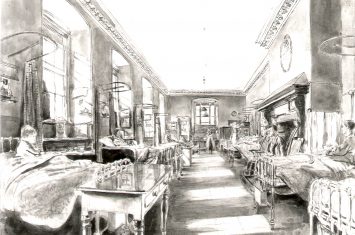
Reflecting on over a century of service, it is abundantly clear that Barts Guild has played a significant role in the life of St Bartholomew’s Hospital, and proudly continues to do so today.
This potted history, written by Phil Moss, is largely based on Ann Wickham’s excellent book A Century of Service that details the first 100 years of the Guild, which is available to purchase in the Guild Shop and online.
| 1911 – 1920 | 1921 – 1930 | 1931 – 1940 | 1941 – 1950 | 1951 – 1960 | 1961 – 1970 |
| 1971 – 1980 | 1981 – 1990 | 1991 – 2000 | 2001 – 2010 | 2011 – 2020 | 2021 – present |
| The Order of Mercy | Guild Patrons, Presidents & Chairmen |
1911 – 1920
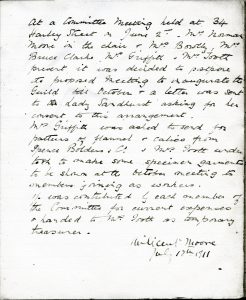
June 2nd 1911 was the red, or rather black and white, letter day for Barts Guild, for on this day the wives of five Barts consultants – Mrs Norman Moore, Mrs Bowlby, Mrs Bruce Clarke, Mrs Griffith, Mrs Tooth – met at 34 Harley Street to discuss the establishment of a Women’s Guild. Later that year, on October 25th, the inaugural meeting took place in the Hospital’s Great Hall, with a committee chaired by Lady Eleanor Sandhurst (who was the daughter of Matthew Arnold, a great poet of the Victorian era).
Its primary aim was to make clothing for inpatients and raise money to purchase the materials, and branches were established across London and the Home Counties. Work parties began in members’ homes and the concept of requiring a subscription from members was introduced.
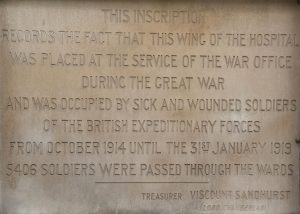
When the Great War broke out, the Hospital became a centre for the treatment of the wounded from France, and the Guild’s needlework expertise came to the fore as patient numbers increased to over 1,200 per year.
After hostilities ended, the Guild organised its first Bazaar, in 1920. Held in the Great Hall and attended by HM Queen Alexandra and other royals, the volunteer-run stalls raised £3,304.8.10d for the Hospital, which is approximately £70,000 in today’s money! The Guild was on its way…
1921 – 1930
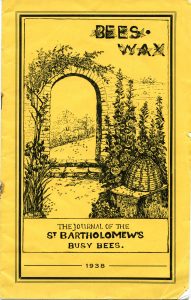 The Guild’s skills with a needle and thread continued in the 1920s, and alongside clothing produced items such as the padding for splints and crutches, the splints themselves, spinal jackets and even canvas boots.
The Guild’s skills with a needle and thread continued in the 1920s, and alongside clothing produced items such as the padding for splints and crutches, the splints themselves, spinal jackets and even canvas boots.
In 1925, it was estimated by the Clerk to the Governors of the Hospital that the Guild’s voluntary work had saved Barts over £700 in one year, and the surgeon Sir Holburt Waring commented that, “After the doctors and nurses had finished their part, the Guild did the rest.”
It wasn’t just clothing that interested the Guild, and in 1929 it had raised over £2,000 (approx. £66,000 today) to help fund a new surgical block (King George V), as well as endowing a new side ward with 2,000 guineas (approx. £75,000 today) to be known in perpetuity as the ‘Guild Ward’.
By 1930 Guild membership had reached 740, and just as in 2017 it was decided to increase this number by reaching out to medical students and their families. What goes around comes around! Another membership initiative was the formation of the ‘Barts Busy Bees’ for younger members and by 1930 there were 600 in the metaphorical Barts beehive!
1931 – 1940
At the AGM that marked the Guild’s ‘coming of age’ in 1932, guest speaker Major Ian Beith “begged everyone to carry on with their splendid work” and that certainly continued up to and during World War II.
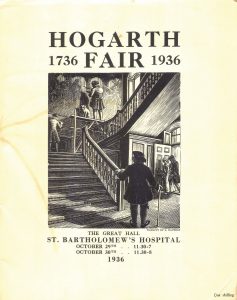 In 1936 the Guild organised a two-day ‘Hogarth Fair’ to coincide with the bicentenary of the Hogarth paintings; it raised a staggering £80,000 in today’s money, of which a quarter was spent equipping a rest room for patients and relatives. Other fundraising activities included the Busy Bees and their annual ‘swarming’ (!), and arranging the film premiere of ‘Gunga Din’, attended by HRHs The Duke & Duchess of Gloucester.
In 1936 the Guild organised a two-day ‘Hogarth Fair’ to coincide with the bicentenary of the Hogarth paintings; it raised a staggering £80,000 in today’s money, of which a quarter was spent equipping a rest room for patients and relatives. Other fundraising activities included the Busy Bees and their annual ‘swarming’ (!), and arranging the film premiere of ‘Gunga Din’, attended by HRHs The Duke & Duchess of Gloucester.
Handiwork was still very much a part of the Guild’s activities, with crutches and splints featuring again, alongside bedding, bed linen and pillows, dressing gowns and clothes for discharged patients. The AGM of 1940 heard that 2,535 garments had been made by Guild volunteers – that’s a lot of material, a lot of time, and a lot of volunteers!
Sadly, this period also saw the passing of the Guild’s inaugural Chairman and President. Lady Eleanor Sandhurst died in 1935, and her death was marked with the dedication of a bed in the Sandhurst Ward. Lady Strafford became the Guild’s second President, but just two years later she resigned. This coincided with the appointment of HRH The Duke of Gloucester as President of the Hospital, and The Duchess accepted an invitation to become President of the Guild, a position she would hold until 1974.
1941 – 1950
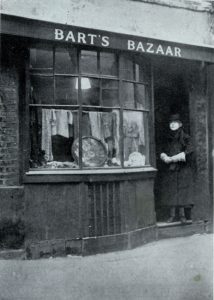 World War II had a dramatic impact upon Barts. The Hospital became one of the largest casualty clearing houses in London, and this in turn placed additional responsibility on the Guild to provide even more clothing and resources to civilian and military patients.
World War II had a dramatic impact upon Barts. The Hospital became one of the largest casualty clearing houses in London, and this in turn placed additional responsibility on the Guild to provide even more clothing and resources to civilian and military patients.
The Guild opened the Barts Bazaar in 1940 on Little Britain, selling donated and crafted goods, and by 1942 annual sales topped £20,000 in today’s money, providing much needed additional income to help the war effort. Sadly, in 1944 Little Britain was hit by a flying bomb and the Bazaar closed before being transferred away from the Guild to the Hospital.
During the war, the Guild lost half of its outlying branches, and subsequently the rest closed down as post-war effects took hold. Not to be downhearted, in 1946 the Guild started up a new service for the Hospital, one that’s still going over 70 years later – the trolley. Within a year it was so successful that a second trolley and store room was added, and rather shockingly one of the top sellers was cigarettes – 2,000 packets a month!
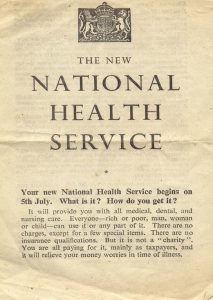 In 1948, the Guild faced an uncertain future due to the creation of the National Health Service (NHS). Chairman Lady Ismay, at the 37th AGM, noted her sadness that “this will be the last meeting with the old regime, as from July 5th we will be placing the results of our hard work into other hands.” It was decided to liquidate the capital that the Guild had accumulated and therefore the Hospital benefitted from a series of special grants.
In 1948, the Guild faced an uncertain future due to the creation of the National Health Service (NHS). Chairman Lady Ismay, at the 37th AGM, noted her sadness that “this will be the last meeting with the old regime, as from July 5th we will be placing the results of our hard work into other hands.” It was decided to liquidate the capital that the Guild had accumulated and therefore the Hospital benefitted from a series of special grants.
1951 – 1960
The creation of the NHS, and the country’s improving economy, had a direct impact on the work of the Guild. By 1953, the Hospital was providing much of the patients’ garments through the NHS and the Guild’s contribution was “just a drop in the ocean” according to work party organiser Lady Paterson-Ross. She reluctantly recommended that the work parties be gradually wound up and the money diverted to other uses. The very reason for the Guild’s creation was being shut down, a sad time for everyone concerned.
However, the trolley service was still extremely popular – although a foray into providing teas and coffees was less than successful and only lasted one year – and funds raised enabled grants to be given to the Hospital for chinaware, hairdryers, irons and ironing boards, radios, and sports equipment to aid patient rehab. Sadly, the Barts Busy Bees buzzed for the last time in 1952 due to a lack of interest from the next generation of youngsters. An early sign of the impact the television would make on society?
The Guild continued to attract interesting speakers for the AGM, notably Florence Nightingale’s biographer Mrs Cecil Woodham-Smith in 1952 – Florence collected much of her data at Barts in 1854 prior to the introduction of her pioneering system of medical statistics – and in 1958 the esteemed poet and writer Sir John Betjeman, who would later in life save the glorious gothic St Pancras Station from the British Rail bulldozers, gave a much-loved speech.
1961 – 1970
While the Guild didn’t necessarily enjoy the Swinging Sixties in quite the same way as the younger generations, it certainly embraced flower power when it opened a florists. And the horticultural involvement didn’t stop there as in 1962 the Guild created the garden behind St Bartholomew the Less that remains to this day.
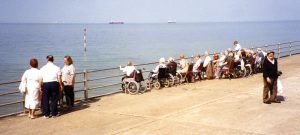 Demand for bed socks kept the volunteers busy knitting, while the shops and trolley continued to provide a valuable service. Outings to the seaside for elderly patients, beginning with a 1966 trip to Southsea, started to become a regular slot in the Guild’s calendar and alongside Christmas parties they continued for over thirty years.
Demand for bed socks kept the volunteers busy knitting, while the shops and trolley continued to provide a valuable service. Outings to the seaside for elderly patients, beginning with a 1966 trip to Southsea, started to become a regular slot in the Guild’s calendar and alongside Christmas parties they continued for over thirty years.
Fundraising events remained ever-present, including various seasonal fairs, a ‘Barts Boutique’ in 1964, and an ‘Everything from Eggs to Evening Dresses’ fair in 1967. Grants awarded included contributions to nurses’ sick rooms and their benevolent fund, prizes and scholarships for students, and £68.16.7d (approx. £800 in today’s money) for a complete Encyclopaedia Britannica for the student nurses’ library.
1971 – 1980
The 70s was a decade of upheaval and change, both for the country and the Guild. In 1973 Britain joined the then European Economic Community (now the EU), and a year later the Guild completely revised its Constitution and merged its Council and Executive Committees to form the Committee of Management, a structure that exists to this day.
The new structure adopted in 1974 also resulted in HRH The Duchess of Gloucester’s role changing and she moved from President to become the Guild’s first Patron, a position she held until her death in 2004.
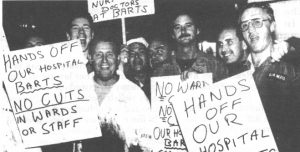
Industrial tensions towards the end of the 70s resulted in mass strikes and the Guild provided volunteers to enable the Hospital to maintain essential services, undertaking the bulk of the domestic work. And in the same year, 1979, that saw Britain’s first female prime minister, the Guild allowed men to join for the first time and changed its name to that which is used today, namely The Guild of the Royal Hospital of St Bartholomew.
1981 – 1990
The Guild’s long-standing fundraising efforts and grant-making continued in the 80s, with fairs and other events contributing to the coffers. In 1982, the annual tradition of a Christmas Concert was born, with the choir formed of members of the Royal Opera House, Covent Garden. A year later the concert raised £17,000 and when added to the proceeds of a fair jointly organised with the Students’ Union, 1983 generated almost £100,000 of new funds in today’s money.
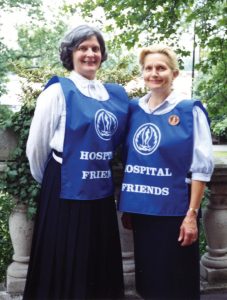
This period also saw the Guild work closely with Great Ormond Street Hospital through its support of the Sick Children’s Trust, which provided accommodation in Surgery House for parents of children receiving treatment at either Barts or Great Ormond Street. And in 1985 a legacy of £48,000 was received from Miss NE Smyrk, a former long-term patient at Barts, which was spent during the following three decades to support patient care.
In June 1990, the Guild was invited to participate in HM The Queen Mother’s 90th birthday celebrations, and Mrs Ann Wickham and Mrs Gillett joined other representatives from the League of Hospital Friends and 6,000 servicemen, women and civilians on Horse Guards Parade. A high honour indeed.
1991 – 2000
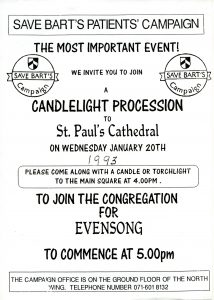 Eighty years of dedication was celebrated on May 15th 1991 at a Thanksgiving Service in St Bartholomew the Less attended by HRH The Duchess of Gloucester, but this decade was marked by external threats to both the Guild and the Hospital.
Eighty years of dedication was celebrated on May 15th 1991 at a Thanksgiving Service in St Bartholomew the Less attended by HRH The Duchess of Gloucester, but this decade was marked by external threats to both the Guild and the Hospital.
WHSmith had opened up a newspaper shop at the Giltspur Street entrance and this resulted in the Guild closing its own newspaper shop, as well as reduced takings in the other shop once Smiths started stocking drinks and confectionery. Fortunately Smiths didn’t stick around for more than a couple of years and the Guild returned to running a successful shop.
However, in 1992 the Tomlinson Report recommended the closure of St Bartholomew’s Hospital, along with nearly half of the inner London hospitals. Throughout the following six years, the Guild was central to the ‘Save Barts Campaign’, especially Guild member Wendy Mead who chaired the campaign, and in 1998 victory was ours when new Health Secretary and local MP Frank Dobson reprieved Barts, to much relief.
2001 – 2010
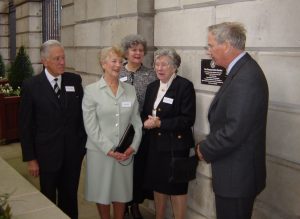
The new millennium thankfully ushered in a more positive period for Barts. In 2001, to commemorate the 100th birthday of the Guild’s Patron, it was decided to rename the garden behind St Bartholomew the Less the ‘Princess Alice Garden’, and once refurbished it was formally opened on October 29th 2004 by her son, HRH The Duke of Gloucester. Sadly, HRH Princess Alice died a few days later.
Also in 2001, the Guild marched for the first time in the Lord Mayor’s Parade, and during the rest of the decade regular events such as the Christmas Concert continued to raise funds and enable our grant-giving to be maintained.
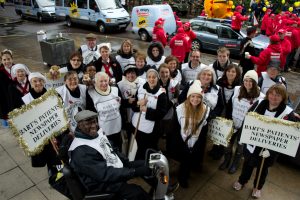
The long-standing flower shop had to be closed in 2006, unfortunately, as the majority of the Hospital’s wards had now banned flowers from patients’ bedsides, but the shop and souvenir sales continued to contribute funds to the coffers.
Also in 2006, HRH The Duke of Gloucester became the first man to occupy a top position within the Guild when he accepted the invitation to succeed his mother as Patron, and a year later Professor Christopher Hudson became the first male Chairman of the Guild, the first of four in a row. Chris would be followed by Andrew Phillips (2012 – 2016), Patrick Jennings (2016 – 2019), Ian McDowell (2019 – 2021, initially as Co-Chair), and Christopher Hayward (2021 onwards).
2011 – 2020
The Guild triumphantly celebrated its centenary on May 25th 2011 with a fair in the Great Hall. There was also a celebratory concert, held at City Temple, Holborn. This welcomed the Barts Chamber Choir and the Trafalgar Sinfonia who gave a fantastic performance of some of Handel’s most popular music. And since the centenary, the Guild has gone from strength to strength, thanks in no small part to the receipt of a number of generous legacies.
In 2014, the Guild moved into its new shop located in the ground floor atrium of the multi-million pound King George V building. This excellent location and the dedication of the Guild’s volunteers who staff the shop has seen turnover dramatically increase, which in turn has enabled more grants to be made available.
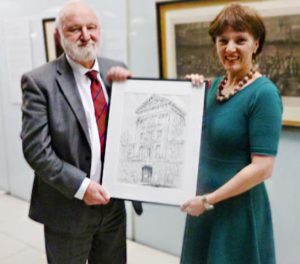
The tradition of attracting eminent speakers to the AGM continued and guests in this decade included the respected historian and broadcaster Michael Wood, the eminent Shakespearean scholar Sir Stanley Wells CBE, and in 2015 Frank Dobson who provided his own insight into the campaign that saved Barts. Sadly, four years later, Frank died on Remembrance Day but his legacy remains to this day.
President Ann Wickham’s 50 years of service to the Guild was recognised in 2016 by The League of Mercy Foundation with the award of the Order of Mercy, which is customarily awarded to 25 outstanding volunteers throughout the UK each year. Also in 2016, Andrew Phillips was succeeded as chairman by Patrick Jennings, making them just the second and third men to lead the Guild.
2017 saw the Guild invest in a much-needed upgrade of its technology, which implemented (in partnership with London-based internet-design consultancy Pedalo) a new website that facilitated online payments for the first time, plus the installation of smart tills for the shop and trolley service, combined with an internal refurbishment of the shop, which all created a much-improved customer experience. The Guild’s Patron, HRH The Duke of Gloucester, visited Barts on October 3rd to formally reopen the shop and he returned in 2019 to visit the redeveloped Princess Alice Garden.
The Guild had a stall at ‘Smithfield 150’ in 2018, a weekend of events based on the old Bartholomew’s Fair that marked the 150th anniversary of the Smithfield markets. Also in that year, the NHS celebrated its 70th anniversary with events at Barts in June and July that were attended by the Guild. And the first Barts Guild Elective Grant was awarded to medical student Mike Willis thanks to the generosity of the Wainwright family.
2020 saw the unexpected and deadly arrival of the Covid-19 pandemic and, as around the country and indeed the world, lives were upended and Barts and the NHS were profoundly affected. Guild volunteers continued to provide support to patients and staff at the Hospital, including keeping the shop open throughout the year. We’re proud to place on record our huge thanks to them and to the NHS staff who battled through the adversity with courage and professionalism.
2021 – present
The Guild should’ve been preparing for a wonderful 2021, celebrating our 110th anniversary, but with the ongoing pandemic and Covid-19 restrictions, the year remained rather low key. Thankfully, medical breakthroughs in Oxford and elsewhere had produced a number of vaccines and gradually Covid-19 became a manageable pandemic. On July 13th, 2022, the Guild’s trolley finally resumed service to the wards at Barts, over two years since its suspension.
 The 900th anniversary of St Bartholomew’s Hospital was celebrated, firstly with a cake-cutting November 2022 visit to the Great Hall by HRH King Charles III and then on March 24th 2023 in the Atrium of the KGV Building, with guest of honour Sir Michael Palin. Sir Michael (pictured) expressed his thanks to Barts for the treatment he had received at the hospital, saying that Barts would always be in his heart – “especially in the aortic artery!” The next day, the actual anniversary of the foundation of the Priory Church of St Bartholomew the Great – the beginning of Barts – was celebrated with a service of thanksgiving. The Guild held its own party to celebrate the 900th in the Princess Alice Garden, with HRH The Duke of Gloucester in attendance once again.
The 900th anniversary of St Bartholomew’s Hospital was celebrated, firstly with a cake-cutting November 2022 visit to the Great Hall by HRH King Charles III and then on March 24th 2023 in the Atrium of the KGV Building, with guest of honour Sir Michael Palin. Sir Michael (pictured) expressed his thanks to Barts for the treatment he had received at the hospital, saying that Barts would always be in his heart – “especially in the aortic artery!” The next day, the actual anniversary of the foundation of the Priory Church of St Bartholomew the Great – the beginning of Barts – was celebrated with a service of thanksgiving. The Guild held its own party to celebrate the 900th in the Princess Alice Garden, with HRH The Duke of Gloucester in attendance once again.

Currently, there is a massive restoration project underway at Barts with the North Wing and Great Hall being refurbished at a cost of £9.5m, thanks in part to a £4.92m grant from the National Lottery Heritage Fund. The Guild donated £50,000 to Barts Heritage, which was matched by Guild member Elizabeth Shaw. The project is on-track to reopen the North Wing during the autumn of 2025.
Historical images sourced from the Guild’s photographic archive, curated by Sue Boswell
The Order of Mercy
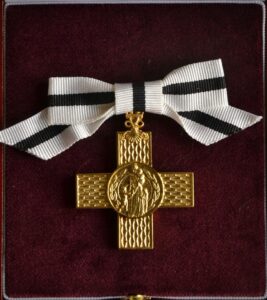 The League of Mercy Foundation was established by Royal Charter of Queen Victoria on March 30th, 1899 and re-established as a charity registered in England on March 30th, 1999. Its original aim was to establish a large body of volunteers to assist with the maintenance of voluntary hospitals and “otherwise relieve sickness and suffering”.
The League of Mercy Foundation was established by Royal Charter of Queen Victoria on March 30th, 1899 and re-established as a charity registered in England on March 30th, 1999. Its original aim was to establish a large body of volunteers to assist with the maintenance of voluntary hospitals and “otherwise relieve sickness and suffering”.
Every year the Order of Mercy is awarded to 50 deserving volunteers from all over the UK who have given personal service over many years, with the medal presented in a magnificent ceremony, most recently at the Mansion House.
We are incredibly proud of the Guild volunteers who have received the Order of Mercy.
2004 – Mrs Elsie Halsey, who ran the souvenir shop
2010 – Mr Malcolm Crisp, who organised grants for the wards
2013 – Mrs Pauline Hirst, Chairman 1980-1983
2014 – Mrs Joyce Malpas, President 1997-2008, Chairman 1989-1992
2016 – Mrs Ann Wickham, President 2008-present, Chairman 1992-1995, 2000-2004
2024 – Ms Jan O’Neill, Editor of Barts Guild News and organiser of the Christmas Concert
